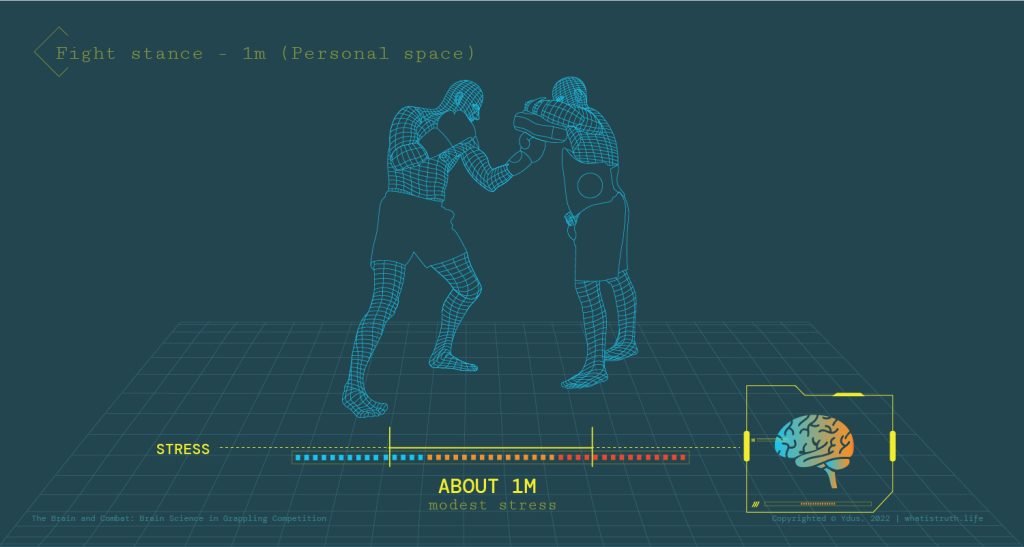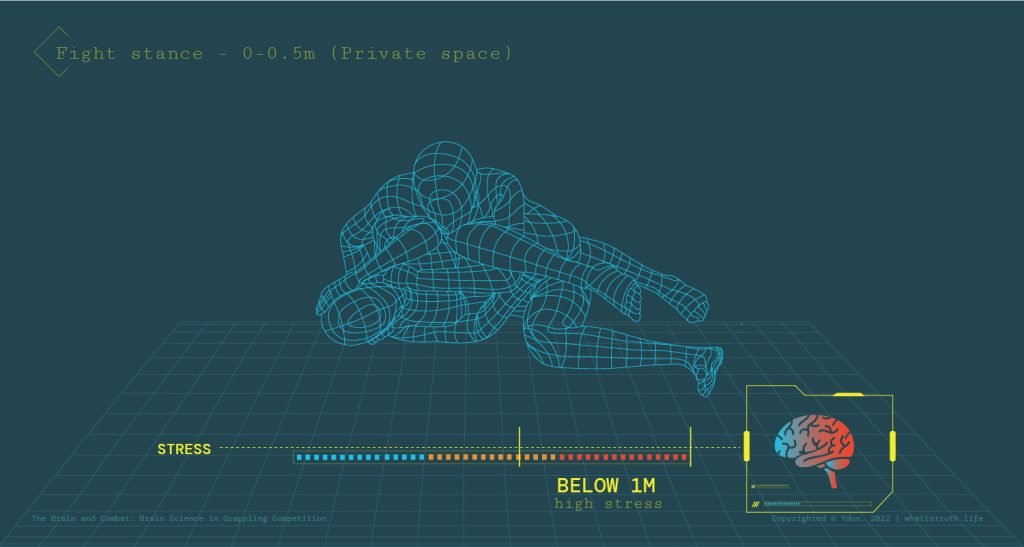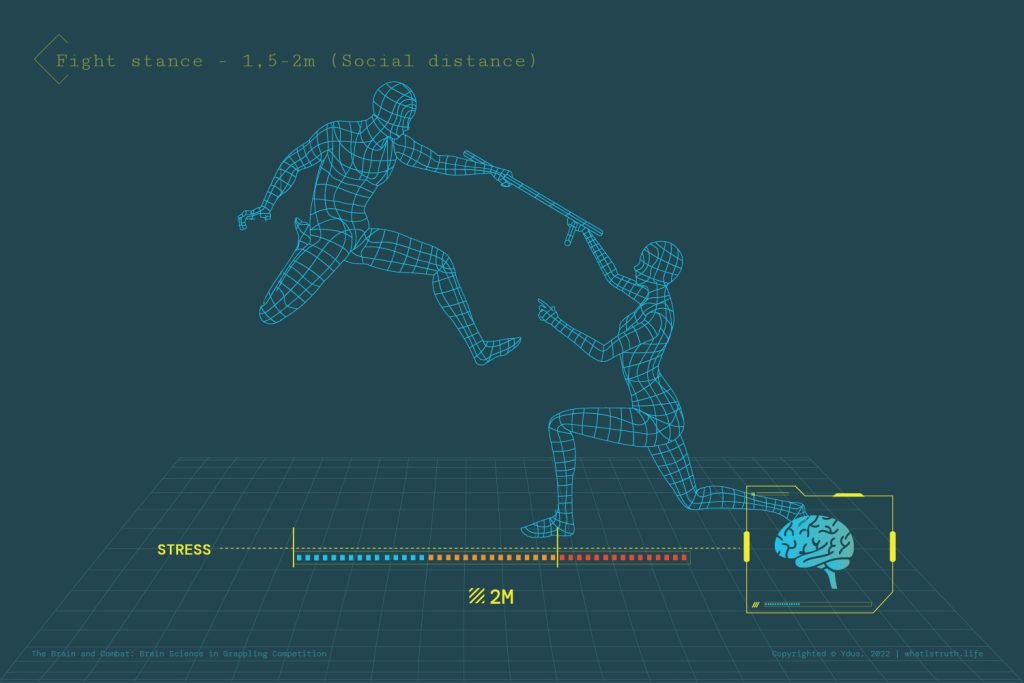There are nearly 200 combative arts, with various trends and cultures favouring different types at different times. Even though most of them have distinct characteristics, there are underlying similarities that can be used to form categories. Categorization is a different art in its own right. But since we’re in the business of competition preparation where good personality match with the chosen martial art is crucial to handle the increasing pressure coming with increasing stakes, we are most interested in the angle that defines what mental design would fit well with a martial art.
When boiling down the differences, we can see a scale of intrusion from light to severe, showing how deeply the players invade each other’s space, and with that, how much their bodies are exposed to injuries. This intrusion also determines the amount of safety one needs to sacrifice to engage in the fight. To put it differently, how much skin and bone they feel comfortable putting into the game. While there is quite good flexibility within one mental design, as pressure increases, a better-fitting natural mental design makes you better able to tolerate the pressure and the further you go. Mind you, working around the less ideal fit can also be done with a good preparation strategy.
The impact of mental design can be seen further down the line in one’s competitive career and is a fundamental part of a winning strategy. Understanding the characteristics of different martial arts and the direct implications of them on progress is necessary for reaching the top. Let’s review the 5 main invasion types that are relevant to a preparation strategy.
Striking arts
Many of the most popular fight sports, such as Boxing, Karate, Muay Thai, amongst others, fall under the category of striking arts, which is also one of the most common combative art forms. The stances of the fighters in these standing games are close to punch and kick range, and they quickly restore their default position and distance after an attack.
Striking sports favour explosiveness. The space available between the fighters in their fighting stance allows for the use of leverage and explosive techniques during a fight. The exposure of the body is moderately because the fighters have the option to withdraw from time to time or increase the distance for strategic reasons. However, closing the distance during the attack is necessary, which exposes the fighters to a counter-attack.

Different striking disciplines concentrate on different limbs as their primary weapon. Taekwondo is known for its kicks, while Boxing is known for its punches. The area to target and the number of body parts that can be used in an attack can vary as well. The range can be quite narrow, like in Boxing, where the punch is always delivered with a fist and only to the head and upper body. Or can be a wide range like in Muay Thai which allows for punches, kicks, knees, and elbows, delivered from different levels to different body parts, significantly increasing the complexity of the game.
Even with moderate involvement that provides the option to withdraw during the game, there is still constant exposure to punches and kicks, which is a dangerous invasion that can result in fatal injuries. The exchanges can become intense and brutal depending on your opponent’s characteristics. For boxers, this means the face/head, with a main organ, the brain, being exposed to damage. The chance of a serious injury is high, and recovering from repeatedly being beaten is hard. Training in striking arts can be traumatic if your personality composition comes with lower conflict resistance and sensitivity to stress. Avoid forcing yourself to adapt. In traits like this, there is a limited movement that the mental design allows, stretching beyond which can lead to trauma.
Grappling arts
Grappling is a combative art where the fight is as close as it gets. The primary focus of grappling arts is usually on groundwork or throws, and they typically do not allow for punches or kicks. Their core principle is to control rather than to strike. Control is definitely present in striking sports as well, but there it’s more about leading and dominating than physically controlling the opponent as in grappling sports. The need for physical control means that in grappling, space between the fighters cannot be maintained. In order to control the opponent’s body, it is necessary to close the distance. That brings a new weapon into the game: body mass.
Grappling is a game that involves a high level of intrusion and exposes all body parts. In the majority of cases, there are no official withdrawal or rest periods or rounds. The bouts are commonly one-round, where minutes feel longer than anywhere else in life. Due to the high intensity, strength and stamina in grappling take precedence over agility and strategy. Having all the limbs, body parts, and body mass involved results in the highest possible game complexity of any type of martial arts. It’s basically like playing body chess with your hair is on fire.
There is a specific mental composition that will thrive in this setup, but for most others, it often presents more challenges. The close contact nature of grappling makes it challenging even during training, let alone during competition. The absence of physical boundaries for the players is extremely intrusive for the brain and depending on one’s natural need for personal space, it can be a discomfort that cannot be overcome.

Various grappling sports have a slightly different focus. Judo and Wrestling place greater emphasis on stand-up throws than BJJ, which is more focused on ground fighting. In most styles, leverage is rarely available because players spend most of their time in close, locked positions. Although blows to the head or body are rare (usually happens unintentionally), there is a significant pressure on the joints and soft tissues, especially in throwing arts like wrestling or Judo. The danger shifts from brain damage that is commonly associated with boxing to joint injuries, neck injuries and impairment. There is also a higher risk of bone breaks and choke-induced death.
Weapon-based arts
There is a vast array of weapons used in martial arts, including swords, staffs, knives, spears, sticks, and even guns. Each weapon has its own unique features that require its users to acquire different skills to manage the tool. One thing is common, though: fighters use an instrument instead of their own body to deliver an attack. This provides a physical and mental distance from the fight.
Weapon-based arts deliver a relatively low level of intrusion compared to the martial arts mentioned earlier, where the main weapon is the body itself. The length of the weapon can make a big difference, however. Arts that feature longer and heavier weapons allow for longer distances from the opponent, basically keeping the body of the fighter safe during the entire attack.

Weapon-based arts are highly relevant in real-life scenarios, even if they are practiced with more traditional weapons. Flashing a weapon is a common way for attackers to reduce their own risk and decrease the chances of a counterattack. In street scenarios, the use of shorter weapons is more prevalent, so disarming would still require scenarios that are known from striking arts. But the presence of a weapon changes the scenario entirely, so those who usually train striking or grappling arts, still can easily find themselves clueless.
Worth noting, that firearms are an exemption as they can kill from a great distance, keeping the attacker’s body completely uninvolved in the conflict, without any exposure to counterattack. Hence its popularity among the public.
In these art forms, the focus shifts from controlling the opponent to controlling the weapon in the hand. When training with a weapon in general, mental skills and mental games are more prominent. Thus, the majority of weapon-based arts do not heavily emphasize physical conditioning and do not require a particularly athletic body type. Mechanical, technical, and strategic instrument use is among the skills prominent.
Meditative/Internal arts
While all martial arts have a meditative aspect and involve an internal journey of self-development, meditative arts such as Tai Chi place this aspect at the forefront of their training. This sets them apart from the disciplines discussed earlier that prioritize physical attributes and technical development and mainly bring the internal state to the forefront when it comes to competition preparation, as the only difference between training and competing is the mental journey involved.
Meditative arts have a very low level of physical intrusion. In fact, usually there is no opponent, so there is no intrusion at all. Therefore, conflict-resistance and other traits that are absolutely essential to other martial arts are not necessary for meditative ones. Rather, slow, graceful movements are the primary focus, with close attention to breath and body coordination.
This approach aids in improving body mechanics and leads to improvements in balance, coordination, and flexibility. Without an opponent or any technique for handing an attack, however, it is not possible to acquire any applicable self-defence skills. Meditative arts are more about preparing the body for better mobility in case you decide to pursue other forms of art in the future.
The absence of physical impact or overexertion of body parts makes meditative arts suitable for seniors and people with physical limitations. However, they also point out a crucial aspect that is often overlooked: without mastering the mind, one cannot gain mastery over the body.
Hybrid/Mixed arts
The majority of mixed arts are a blend of various striking and grappling styles. They demand more of the body because they require the skills of both grappling and striking. Their characteristics are closer to striking arts due to the default stance, which allows them to withdraw and re-strategise. The grappling components are typically employed to close the deal instead of being the main format of the fight. The unpredictable nature of the game flow is also closer to the fluctuation and required agility of striking arts.
The intrusion level of hybrid styles falls somewhere between striking and grappling art, with the injury potential as high or often even surpassing that of grappling. The need for multiple art forms comes with the new problem of time and resource management. It’s hard to allocate the same amount of time to train in both striking and grappling simultaneously. Also, to balance the pressure put on the body by training for both grappling and striking needs in MMA. In most instances, it is common to first master one art form and then expand your knowledge or diversify your skills by beginning to train another.
Success at the professional level in MMA is often said to be nonlinear and more difficult to pin down its components. When you compete in Boxing, for example, you’re competing against people who train exclusively in Boxing and have very similar niche skills and blueprint of fighting. In MMA, skills can vary greatly, resulting in matches with often highly asymmetrical skills between the fighters, leaving a lot of room for manoeuvring, which is not available against a same-niche opponent.
Mixed arts are the game of whatever works. They are very similar to street fights, with the only difference being the safety net provided by the referee and some rules. There are significant trade-offs in terms of health associated with this. The unpredictable nature and high intensity usually take a toll on both the body and mind of fighters. Injuries are a common and serious occurrence, as are mental traumas. Even if you have a suitable mental design to cope with the pressure, it’s recommended to build a quick career instead of committing to it as a lifestyle.
Conclusion
The categorization used in this article follows the angle that is most relevant for competition preparation, namely the level of intrusion of the art forms, which determine the mental cards that are most compatible. As you read through the article, you probably felt a certain emotional reaction to each of the martial arts categories discussed. Check which resonated with you, especially if you are training with competing goals. Because while any martial arts that provide the appropriate level of challenge and support is good for personal growth, when competing and winning is the main goal, it is crucial to choose those that align best with your body type, mental makeup, and strengths.




